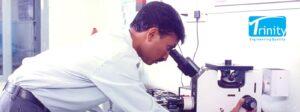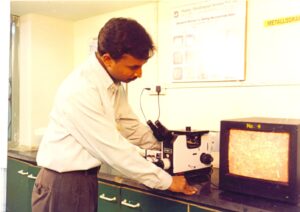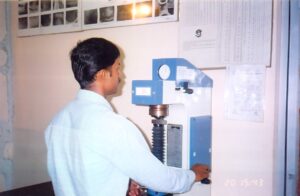Onsite NDT services and Material Testing labs
Metallurgical analysis and crack detection facilities
- Home »
- Material Testing »
Material Testing Service Labs
Trinity NDT material testing laboratory is located at the core of industrial area in Peenya Industrial Estate, Bangalore in India, catering to the needs of various engineering industries. The laboratory is equiped with material testing facilities to conduct following metallurgical tests and is in the process of adding more services in the near future.
Microstructure Analysis

The optical microscope is the principal tool used to characterize the internal grain structure of steel. Traditionally, the structure revealed by the microscope is called the microstructure. The mechanical properties of a given steel are strongly influenced by its microstructure. An optical microscope uses reflected light to generate an image. A beam of light is directed down onto the surface and the image is generated either on film or the eye by light reflected along the same direction.
This is performed on specimens either cut to size or mounted in a resin mold. The samples are polished to a fine finish, normally one micron diamond paste, and usually etched in an appropriate chemical solution prior to examination on a metallurgical microscope.
Whats’ app us your Testing Inquiry now.
Macro Examination
Metallic specimen cross sections cut from a component or sample are macroscopically examined by light illumination in order to reveal various important macro structural features such as Flow lines in wrought products, Solidification structures in cast products, Weld characteristics, including depth of penetration, fusion-zone size and number of passes, size of heat-affected zone, and type & density of weld imperfections, general size and distribution of large inclusions & stringers, fabrication imperfections such as laps, cold welds, folds and seams in wrought products, Gas and shrinkage porosity in cast products, depth & uniformity of a hardened layer in a case-hardened products. Macroscopic examination of the component surface is also essential in evaluating many more characteristics of metallic objects.
Estimation of Grain Size
Grains in metals are irregular shaped structures which makes it difficult to easily characterize their size. ASTM International adapted a method for measuring grain size in 1947 that is widely used for characterizing grain size in steels. In order to establish a scale for grain size, ASTM E112 shows charts with outline grain structures at various dimensions. The very coarse sizes are starting from 1 (very coarse) encountered in large ingots or in steels held near their melting points for long times. The finest sizes can be up to 10 (very fine) are encountered in steels given special treatments that inhibit grain growth. Grain size is determined from a polished and etched sample using optical microscopy at a magnification of 100X
Evaluating the case depth

The depth of the layer affected by the surface hardening treatment is commonly referred to as the case depth. Surface heat treatment involves heating a steel part very rapidly above the AC3 temperature, resulting in a thin layer of austenite on the surface. The part is then quenched, which produces a thin layer of martensite on the surface. The common, traditional techniques for surface heat treating are case carburizing, nitriding, carbonitriding, cyaniding, flame hardening and induction hardening. More sophisticated and expensive techniques involve heating the surface by laser beams or by electron beams. Test methods for evaluation of case depth by means of chemical, mechanical or visual are available and should be selected on the basis of specific requirements.
Decarburization depth
The oxygen in the air will react with the carbon atoms at the surface and form gaseous molecules of carbon dioxide (CO2), which will then drift away from the surface, removing carbon. This process is called decarburization, and it can be a big problem during hot working and heat treatment of steels.
Hardness tests

A problem with the tensile test is that the metal is destroyed by the test. Another test that characterizes the strength of a metal but does not destroy the metal is the hardness test. This test is used widely because it is quick and can be applied to parts that can then be placed into service. A hard material, called the indenter, is forced into the metal surface with a fixed load (weight). The metal region located under the indenter point is deformed to strains well into the plastic region of the specimen, so that permanent deformation is generated, causing a crater (called an indent) to be left in the metal surface. The hardness is then defined by some number that is proportional to the size of the indent. In some techniques, the size of the indent is measured from its diameter, and in others, it is measured from the depth of the indent.
Our Other Material testing Services

Other quality services includes

